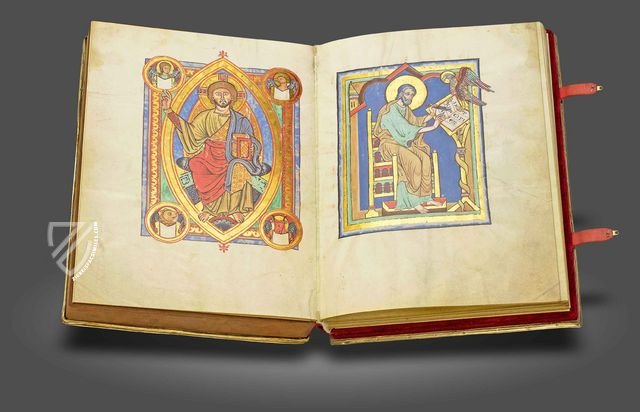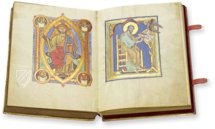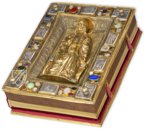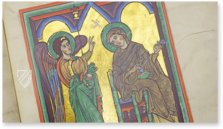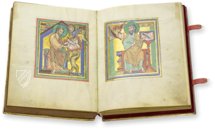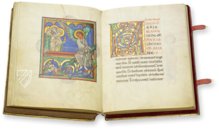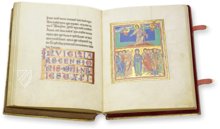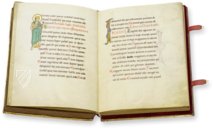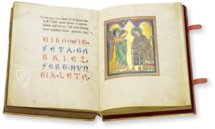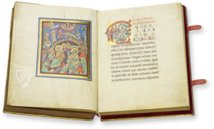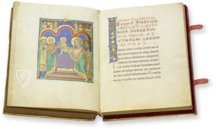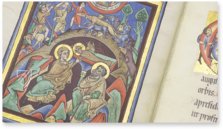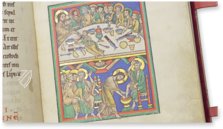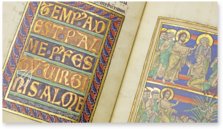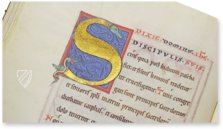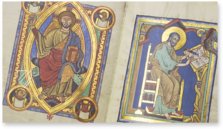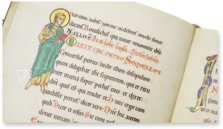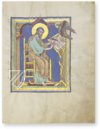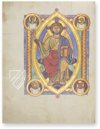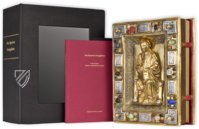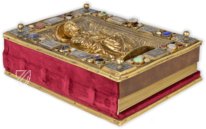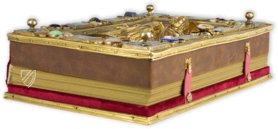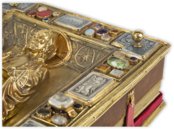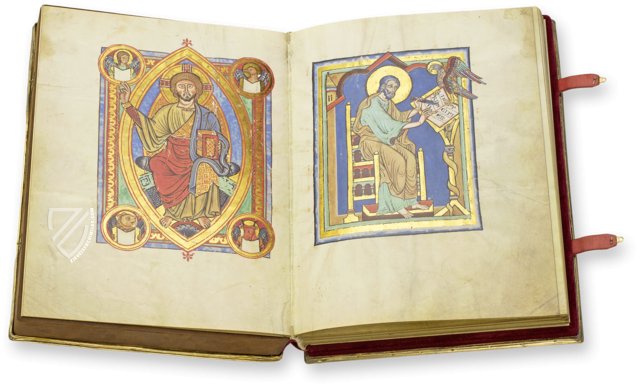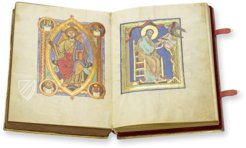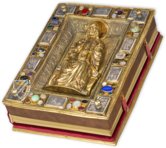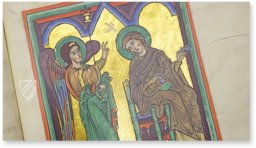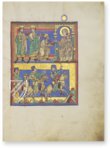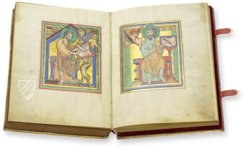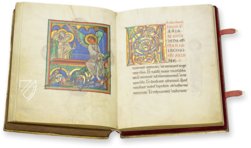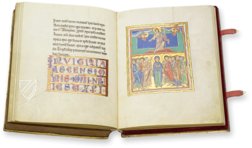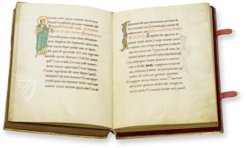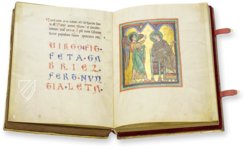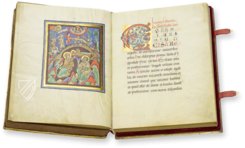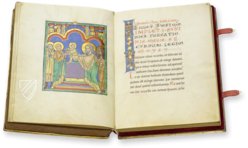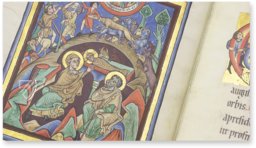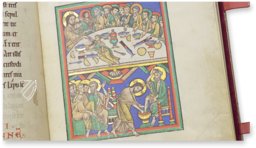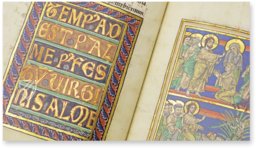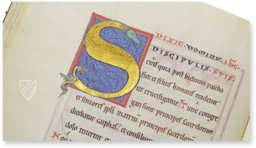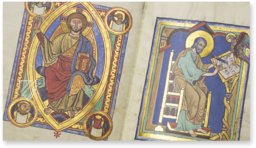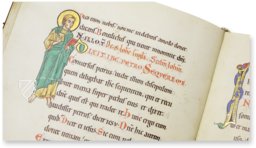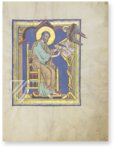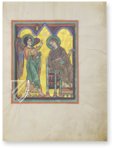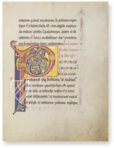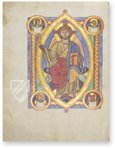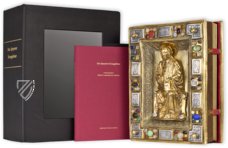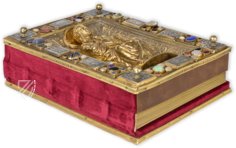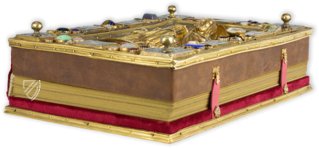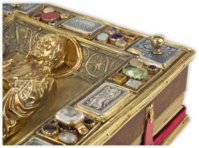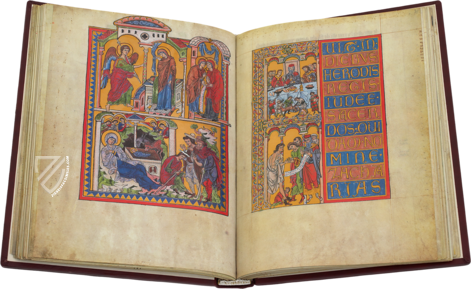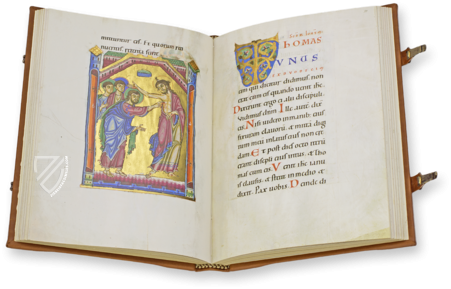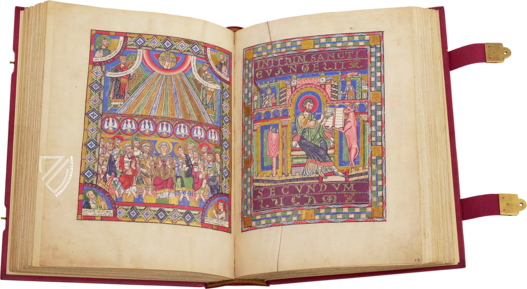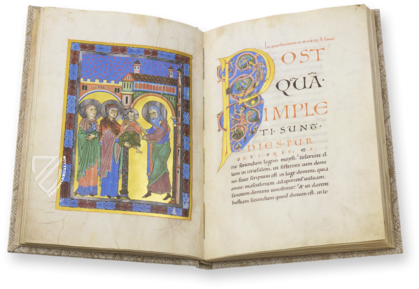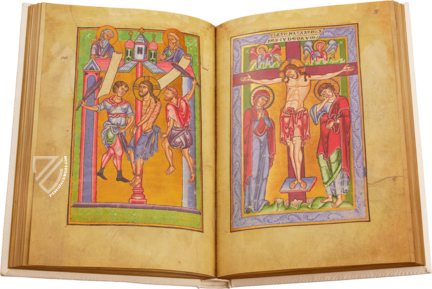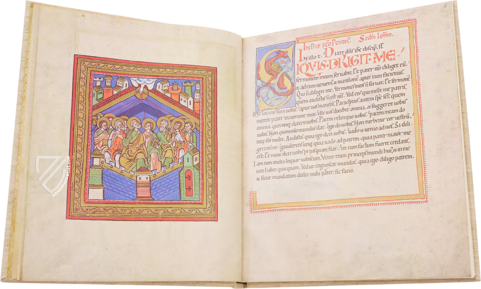Speyer Pericopes
(over 10,000€)
The Speyer Pericopes is an extraordinary magnificent manuscript for the celebration of the liturgical feast days in Speyer Cathedral and was created around 1220 for Konrad IV von Tann (1233 - 1236), who had connections in the highest social circles and later became Bishop of Speyer. Eight talented book artists from Speyer or Trier were responsible for the amazing picture program comprising 22 expressive, gold-decorated miniatures and 70 ornate decorated initials, which has not lost any of its charisma or colour intensity to this day. In keeping with the sacred texts, it features New Testament scenes as well as full-page portraits of the writing Evangelists and an enthroned Christ. Remarkably, the exceptionally sumptuous historical binding of the opulent codex has also been preserved, displaying dozens of precious gemstones and engraved silver plaques framing a gilded figurine of Christ, which probably replaced the original center of the book cover in the 15th century.
The Speyer Pericopes
A pericope contains readings from the gospels that are organized around church festivals and were recited at religious services. For the readings on feast days at the Speyer Cathedral, a truly unique pericope was produced that is astounding to this day. The Speyer Pericopes consists of 154 pages with 17 full page, intensely colored miniatures. These are divided into 21 individual pictures and depict scenes from the New Testament. Furthermore, it comprises four full-page depictions of the four Evangelists and Christ as well as 70 richly adorned historiated initials. The exceedingly magnificent binding of the codex underlines its importance for the bishopric of Speyer and makes the work one of the most beautiful manuscripts of late German Romanic.
A Successful Collaboration
The Speyer Pericopes was commissioned around 1220 by the late bishop of Speyer, Konrad IV of Tann. He wanted to give birth to a showcase work that was intended for use on feast days. In total eight involved artists can be distinguished. For the script, in which particularly important passages were highlighted with gold, blue, or red-black, five artists were responsible. They probably came from an educated monastic background. The exceptional miniatures and decorative initials were derived from the hands of three fabulously talented masters from Speyer or Trier who set a new standard with their painting.
New Creative Influences
In the early 12th and 13th centuries, German book illuminators came to grips with the artistic achievements of the Mediterranean and Byzantine cultural sphere. This was a result of the Crusades and the Staufer domains in Italy. These new artistic trends strongly influenced occidental art and changed their style and aesthetic permanently. The painters of the Speyer Pericopes also integrated Byzantine impulses in their painting. They carefully paid attention to the individual facial features of their figures, depicting most people in conversation with one another, paid attention to realistic representations of garments, and achieved advancements in the anatomically correct depiction of people. They also included completely new pictorial composition in their work, for example the birth of Jesus was not depicted in a stable but in a hollow. With powerful colors they underscored the liveliness and plasticity of their miniatures. The backgrounds of the pictures are an intense blue for the most part, which create a stark contrast with high-luster polished gold in nearly every depiction.
An Immeasurable Richness of Book Decoration
The initials of the work also exceed the usual decoration of large letters, the 70 initials are miniatures unto themselves. They pictorially depict scenes from selected Bible readings and capture the Byzantine motif of the miniatures in a similar fashion, for example the washing of the Christ child. The costliest element of the Speyer Pericopes is nonetheless its monumental binding. It consists of over 150 individual parts. A gilded silver figure of Christ on his throne is embedded in the middle, which is surrounded by countless relief-like gold ornaments and precious stones. Using the so-called niello technique, small stones were infused in silver. Precious stones from around the world are found in the binding, among them amethyst, lapis lazuli, agates, and pure quartz. Only a few manuscripts from the 13th century still possess their original bindings. The binding was also probably reworked in the 15th century, it was on this occasion that the gilded Jesus figure was applied as a replacement for a previous figure and the work was affixed with a golden frame.
Codicology
- Alternative Titles
- Speyerer Evangelistar
Speyerer Perikopenbuch
L’Évangéliaire de Spire - Size / Format
- 154 pages / 33.2 × 25.3 cm
- Origin
- Germany
- Date
- Around 1220
- Epochs
- Style
- Language
- Script
- Gothic
- Illustrations
- 17 full-page miniatures made up of 21 individual images, 5 full-page portraits of the Evangelists and Christ and 70 richly decorated historiated initials
- Patron
- Konrad IV von Tann, cathedral curator and Bishop of Speyer (1233–1236)
- Artist / School
- Three masters from Speyer or Trier
Speculum Humanae Salvationis from Einsiedeln Abbey
Portrait of John the Evangelist
Saint John is depicted as a bearded man of advanced age with his brow furrowed in thought and a golden halo embossed with delicate patterns. He is sitting at a lectern with an animal head, a stylus in his right hand and a small pen knife in his left. An eagle with spectacular plumage and its own gold leaf halo, his Evangelist Symbol, appears to have just flown into the scene, perching itself in front of Saint John as though it is turning the pages with its talons.
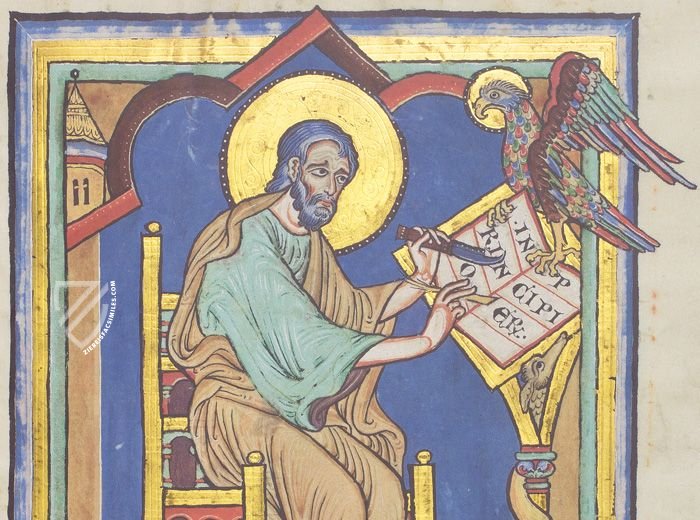
Speyer Pericopes
Adoration of the Magi
This dynamic miniature is split into two registers, with the scene in the lower register preceding the one on top. Guided by the Star of Bethlehem, which is outside of the frame, the Magi ride from the East through the mountains by night, indicated by their blue crowns. They are dressed in contemporary court fashions with black tights and colorful, flowing robes.
The upper register depicts the archetypal scene of the Magi presenting their gifts to the Baby Jesus and Virgin Mary, who both make iconic hand gestures associated with holiness. No manger is present, nor are they pictured in the humble surroundings described in the Gospels. Instead, Mary is enthroned like a queen receiving the supplications of her vassals to their newborn king.
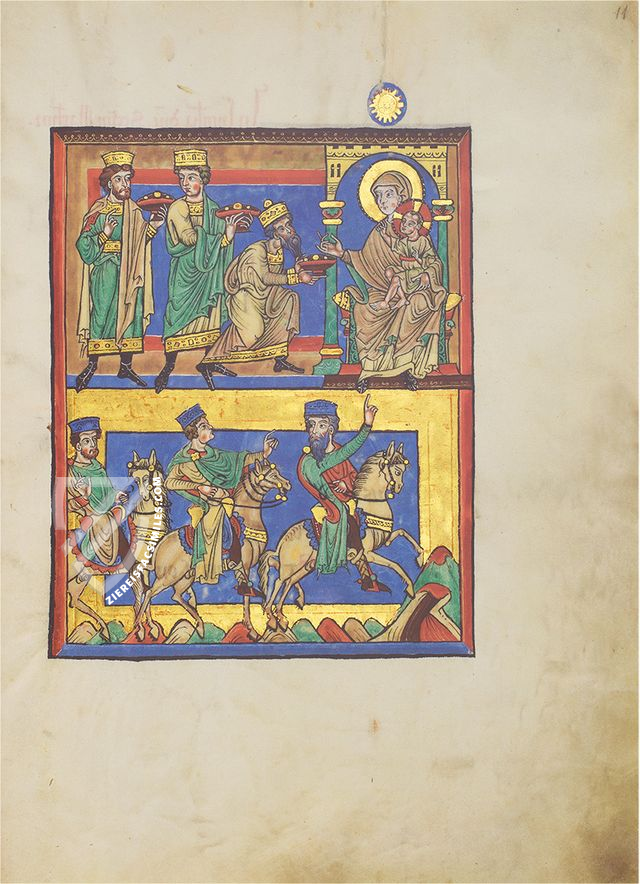
#1 Speyerer Evangelistar
Languages: English, German
(over 10,000€)
- Treatises / Secular Books
- Apocalypses / Beatus
- Astronomy / Astrology
- Bestiaries
- Bibles / Gospels
- Chronicles / History / Law
- Geography / Maps
- Saints' Lives
- Islam / Oriental
- Judaism / Hebrew
- Single Leaf Collections
- Leonardo da Vinci
- Literature / Poetry
- Liturgical Manuscripts
- Medicine / Botany / Alchemy
- Music
- Mythology / Prophecies
- Psalters
- Other Religious Books
- Games / Hunting
- Private Devotion Books
- Other Genres
- Afghanistan
- Armenia
- Austria
- Belgium
- Belize
- Bosnia and Herzegovina
- China
- Colombia
- Costa Rica
- Croatia
- Cyprus
- Czech Republic
- Denmark
- Egypt
- El Salvador
- Ethiopia
- France
- Germany
- Greece
- Guatemala
- Honduras
- Hungary
- India
- Iran
- Iraq
- Israel
- Italy
- Japan
- Jordan
- Kazakhstan
- Kyrgyzstan
- Lebanon
- Liechtenstein
- Luxembourg
- Mexico
- Morocco
- Netherlands
- Palestine
- Panama
- Peru
- Poland
- Portugal
- Romania
- Russia
- Serbia
- Spain
- Sri Lanka
- Sweden
- Switzerland
- Syria
- Tajikistan
- Turkey
- Turkmenistan
- Ukraine
- United Kingdom
- United States
- Uzbekistan
- Vatican City
- A. Oosthoek, van Holkema & Warendorf
- Aboca Museum
- Ajuntament de Valencia
- Akademie Verlag
- Akademische Druck- u. Verlagsanstalt (ADEVA)
- Aldo Ausilio Editore - Bottega d’Erasmo
- Alecto Historical Editions
- Alkuin Verlag
- Almqvist & Wiksell
- Amilcare Pizzi
- Andreas & Andreas Verlagsbuchhandlung
- Archa 90
- Archiv Verlag
- Archivi Edizioni
- Arnold Verlag
- ARS
- Ars Magna
- ArtCodex
- AyN Ediciones
- Azimuth Editions
- Badenia Verlag
- Bärenreiter-Verlag
- Belser Verlag
- Belser Verlag / WK Wertkontor
- Benziger Verlag
- Bernardinum Wydawnictwo
- BiblioGemma
- Biblioteca Apostolica Vaticana (Vaticanstadt, Vaticanstadt)
- Bibliotheca Palatina Faksimile Verlag
- Bibliotheca Rara
- Boydell & Brewer
- Bramante Edizioni
- Bredius Genootschap
- Brepols Publishers
- British Library
- C. Weckesser
- Caixa Catalunya
- Canesi
- CAPSA, Ars Scriptoria
- Caratzas Brothers, Publishers
- Carus Verlag
- Casamassima Libri
- Centrum Cartographie Verlag GmbH
- Chavane Verlag
- Christian Brandstätter Verlag
- Circulo Cientifico
- Club Bibliófilo Versol
- Club du Livre
- CM Editores
- Collegium Graphicum
- Collezione Apocrifa Da Vinci
- Comissão Nacional para as Comemorações dos Descobrimentos Portugueses
- Coron Verlag
- Corvina
- CTHS
- D. S. Brewer
- Damon
- De Agostini/UTET
- De Nederlandsche Boekhandel
- De Schutter
- Deuschle & Stemmle
- Deutscher Verlag für Kunstwissenschaft
- DIAMM
- Droz
- E. Schreiber Graphische Kunstanstalten
- Ediciones Boreal
- Ediciones Grial
- Ediclube
- Edições Inapa
- Edilan
- Editalia
- Edition Deuschle
- Edition Georg Popp
- Edition Leipzig
- Edition Libri Illustri
- Editiones Reales Sitios S. L.
- Éditions de l'Oiseau Lyre
- Editions Medicina Rara
- Editorial Casariego
- Editorial Mintzoa
- Editrice Antenore
- Editrice Velar
- Edizioni Edison
- Egeria, S.L.
- Eikon Editores
- Electa
- Emery Walker Limited
- Enciclopèdia Catalana
- Eos-Verlag
- Ephesus Publishing
- Ernst Battenberg
- Eugrammia Press
- Extraordinary Editions
- Fackelverlag
- Facsimila Art & Edition
- Facsimile Editions Ltd.
- Facsimilia Art & Edition Ebert KG
- Faksimile Verlag
- Feuermann Verlag
- Folger Shakespeare Library
- Franco Cosimo Panini Editore
- Friedrich Wittig Verlag
- Fundación Hullera Vasco-Leonesa
- G. Braziller
- Gabriele Mazzotta Editore
- Gebr. Mann Verlag
- Gesellschaft für graphische Industrie
- Getty Research Institute
- Giovanni Domenico de Rossi
- Giunti Editore
- Graffiti
- Grafica European Center of Fine Arts
- Guido Pressler
- Guillermo Blazquez
- Gustav Kiepenheuer
- H. N. Abrams
- Harrassowitz
- Harvard University Press
- Helikon
- Hendrickson Publishers
- Henning Oppermann
- Herder Verlag
- Hes & De Graaf Publishers
- Hoepli
- Holbein-Verlag
- Houghton Library
- Hugo Schmidt Verlag
- Idion Verlag
- Il Bulino, edizioni d'arte
- ILte
- Imago
- Insel Verlag
- Insel-Verlag Anton Kippenberger
- Instituto de Estudios Altoaragoneses
- Instituto Nacional de Antropología e Historia
- Introligatornia Budnik Jerzy
- Istituto dell'Enciclopedia Italiana - Treccani
- Istituto Ellenico di Studi Bizantini e Postbizantini
- Istituto Geografico De Agostini
- Istituto Poligrafico e Zecca dello Stato
- Italarte Art Establishments
- Jan Thorbecke Verlag
- Johnson Reprint Corporation
- Josef Stocker
- Josef Stocker-Schmid
- Jugoslavija
- Karl W. Hiersemann
- Kasper Straube
- Kaydeda Ediciones
- Kindler Verlag / Coron Verlag
- Kodansha International Ltd.
- Konrad Kölbl Verlag
- Kurt Wolff Verlag
- La Liberia dello Stato
- La Linea Editrice
- La Meta Editore
- Lambert Schneider
- Landeskreditbank Baden-Württemberg
- Leo S. Olschki
- Les Incunables
- Liber Artis
- Library of Congress
- Libreria Musicale Italiana
- Lichtdruck
- Lito Immagine Editore
- Lumen Artis
- Lund Humphries
- M. Moleiro Editor
- Maison des Sciences de l'homme et de la société de Poitiers
- Manuscriptum
- Martinus Nijhoff
- Maruzen-Yushodo Co. Ltd.
- MASA
- Massada Publishers
- McGraw-Hill
- Metropolitan Museum of Art
- Militos
- Millennium Liber
- Müller & Schindler
- Nahar - Stavit
- Nahar and Steimatzky
- National Library of Wales
- Neri Pozza
- Nova Charta
- Oceanum Verlag
- Odeon
- Orbis Mediaevalis
- Orbis Pictus
- Österreichische Staatsdruckerei
- Oxford University Press
- Pageant Books
- Parzellers Buchverlag
- Patrimonio Ediciones
- Pattloch Verlag
- PIAF
- Pieper Verlag
- Plon-Nourrit et cie
- Poligrafiche Bolis
- Presses Universitaires de Strasbourg
- Prestel Verlag
- Princeton University Press
- Prisma Verlag
- Priuli & Verlucca, editori
- Pro Sport Verlag
- Propyläen Verlag
- Pytheas Books
- Quaternio Verlag Luzern
- Reales Sitios
- Recht-Verlag
- Reichert Verlag
- Reichsdruckerei
- Reprint Verlag
- Riehn & Reusch
- Roberto Vattori Editore
- Rosenkilde and Bagger
- Roxburghe Club
- Salerno Editrice
- Saltellus Press
- Sandoz
- Sarajevo Svjetlost
- Schöck ArtPrint Kft.
- Schulsinger Brothers
- Scolar Press
- Scrinium
- Scripta Maneant
- Scriptorium
- Shazar
- Siloé, arte y bibliofilia
- SISMEL - Edizioni del Galluzzo
- Sociedad Mexicana de Antropología
- Société des Bibliophiles & Iconophiles de Belgique
- Soncin Publishing
- Sorli Ediciones
- Stainer and Bell
- Studer
- Styria Verlag
- Sumptibus Pragopress
- Szegedi Tudomànyegyetem
- Taberna Libraria
- Tarshish Books
- Taschen
- Tempus Libri
- Testimonio Compañía Editorial
- Thames and Hudson
- The Clear Vue Publishing Partnership Limited
- The Facsimile Codex
- The Folio Society
- The Marquess of Normanby
- The Richard III and Yorkist History Trust
- Tip.Le.Co
- TouchArt
- TREC Publishing House
- TRI Publishing Co.
- Trident Editore
- Tuliba Collection
- Typis Regiae Officinae Polygraphicae
- Union Verlag Berlin
- Universidad de Granada
- University of California Press
- University of Chicago Press
- Urs Graf
- Vallecchi
- Van Wijnen
- VCH, Acta Humaniora
- VDI Verlag
- VEB Deutscher Verlag für Musik
- Verlag Anton Pustet / Andreas Verlag
- Verlag Bibliophile Drucke Josef Stocker
- Verlag der Münchner Drucke
- Verlag für Regionalgeschichte
- Verlag Styria
- Vicent Garcia Editores
- W. Turnowski Ltd.
- W. Turnowsky
- Waanders Printers
- Wiener Mechitharisten-Congregation (Wien, Österreich)
- Wissenschaftliche Buchgesellschaft
- Wissenschaftliche Verlagsgesellschaft
- Wydawnictwo Dolnoslaskie
- Xuntanza Editorial
- Zakład Narodowy
- Zollikofer AG

